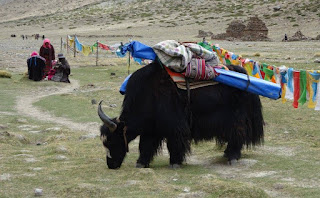Tibet
[English below] Tibet siempre ha significado un territorio enigmático. Referente de sosiego, meditación y paz, con el Dalai Lama a la cabeza. Escondite del mítico Shangri-La, refugio para el cuerpo y el alma. Escenario de terribles persecuciones y represión bajo la ocupación china...
Estando en Nepal era una pena no darse un saltito, sobre todo durante el mes de junio en que se celebra el Saga Dawa Festival para homenajear el nacimiento, iluminación y muerte de Buda. Nadie sabe qué va a ser de este legado tibetano una vez que el octogenario Dalai Lama ya no esté para pacificar a su pueblo oprimido.
Viniendo de Katmandu, Lhasa -la capital del Tíbet- me parecio una ciudad muy avanzada, con buenas infraestructuras y mucha más libertad religiosa de lo que me temía. Parece que después de muchos años -desde 1959- tratando de erradicar la identidad tibetana, el gobierno chino afloja un poco el yugo colonialista sobre lo que queda de cultura tibetana.
De los dias pasados en Tibet me llevo principalmente tres entrañables recuerdos:
Por un lado, la cordillera del Himalaya nos regaló hermosas vistas de sus grandes montañas: Makalu (8481m), Cho Oyu (8201m), Lhotse (8516m), Annapurna (8091m), Shisha Pangma (8027m) y el imponente Monte Everest (8848m). Me sobrecogió contemplar esos gigantes pensando en los montañeros que cada año están dispuestos a morir -como así ocurre- por coronar sus cimas.
Desde un punto de vista espiritual, la devoción que se puede ver en todo el Tíbet es conmovedora. Pero en la peregrinación alrededor del Monte Kailash -la montaña más sagrada de Asia- para celebrar el Saga Dawa Festival, esa devoción llega a su cénit con peregrinos venidos de todo el Tíbet, India, Nepal y otras regiones del mundo. La peregrinación consiste en una ruta circular, generalmente de 3 días, partiendo de unos 4700 m y con un paso nevado a 5600 m. Era admirable sentir la intensidad de esa caravana de almas dispuestas a padecer la severidad del terreno con tal de culminar su anhelo.
Por último, no puedo olvidarme de la convivencia de esos dias, pues la única forma de visitar Tíbet es uniéndose a un tour organizado, así que cambié mi típica forma solitaria y sin rumbo de viajar y disfruté durante 16 días de la compañía de otros 11 compañeros y la organización de una guía y conductor tibetanos. Las experiencias vividas durante esa convivencia constituyeron todo un laboratorio social que disfruté intensamente.
***********************************
Tibet has always reminded me an enigmatic territory. Reference for meditation and peace, with the Dalai Lama at its head. Hideaway of the mythical Shangri-La, refuge for body and soul. Scenario of terrible persecutions and repression under Chinese occupation ...
Being in Nepal was a shame not to give a jump, especially during June when the Saga Dawa Festival is celebrated to honor the birth, enlightenment and death of Buddha. No one knows what will happen to this Tibetan legacy once the octogenarian Dalai Lama is no longer to pacify his oppressed people.
Coming from Kathmandu, I found Lhasa - the capital of Tibet - a very advanced city, with good infrastructure and much more religious freedom than I supposed. It seems that after many years - since 1959 - trying to eradicate the Tibetan identity, the Chinese government slightly raise the colonialist yoke on what is left of Tibetan culture.
From the days spent in Tibet, I kept mainly three deep memories:
On the one hand, the Himalayan mountain range gave us beautiful views of its great mountains: Makalu (8481m), Cho Oyu (8201m), Lhotse (8516m), Annapurna (8091m), Shisha Pangma (8027m) and the impressive Mount Everest (8848m). I was delighted to look at those giants thinking of the mountaineers that every year are able to take the risk even to die - as it happens - for crowning their summits.
From a spiritual point of view, the devotion that can be seen throughout Tibet is touching. But on the pilgrimage around Mt. Kailash - the holiest mountain in Asia - to celebrate the Saga Dawa Festival, that devotion reaches its zenith with pilgrims from all over Tibet, India, Nepal and other regions of the world. The pilgrimage consists of a circular route, generally of 3 days, starting from about 4700 m and with a snowy step to 5600 m. It was admirable to feel the intensity of this caravan of souls ready to suffer the severity of the trail in order to complete its longing.
Finally, I can not forget the coexistence of those days, because the only way to visit Tibet is joining an organized tour, so I changed my typical lonely and without direction way of traveling and I enjoyed for 16 days the company of 11 other partners and the organization of a Tibetan guide and driver. The experiences lived during this coexistence constituted a whole social laboratory that I enjoyed intensely.
















No hay comentarios:
Publicar un comentario